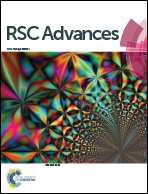Photoexcited state chirality transfer. Hidden tunability of circularly polarized luminescent binaphthyl–anthracene tandem molecular systems†
Abstract
Circularly polarized luminescent properties of C2-symmetrical binaphthyl molecular systems bearing two achiral anthracenes as luminophores were tuned by solely exploiting photoexcited-state chirality transfer from the binaphthyl to anthracenes when open- or closed-type binaphthyl structure as non-luminophore were chosen.


 Please wait while we load your content...
Please wait while we load your content...